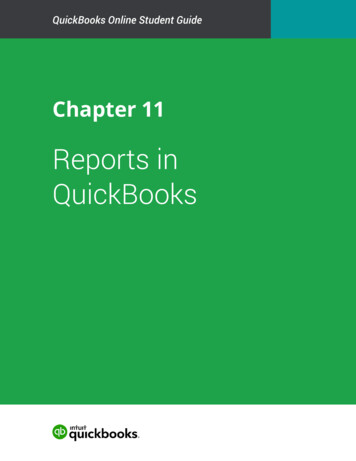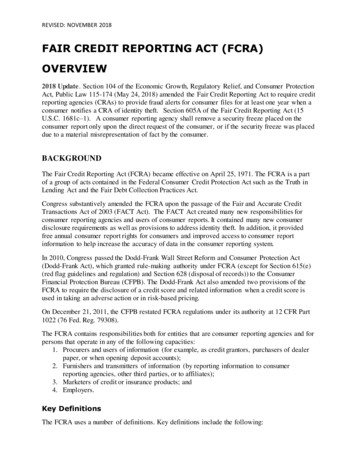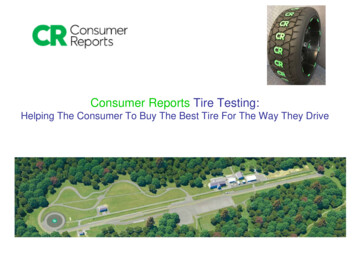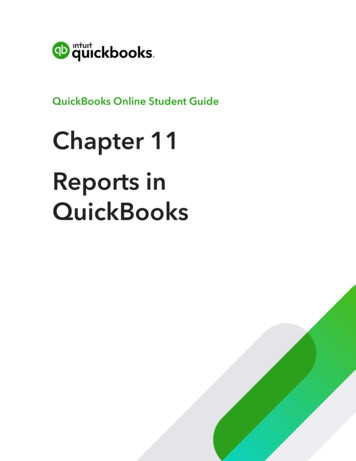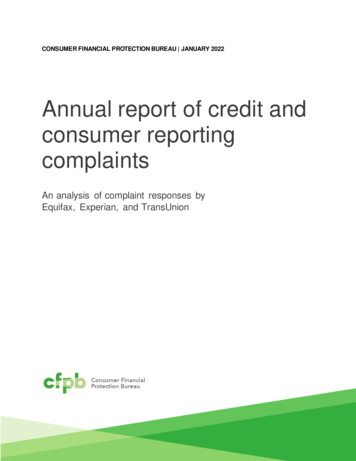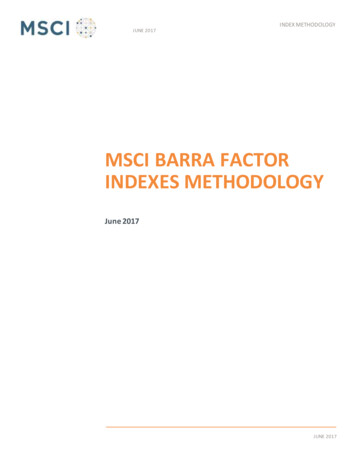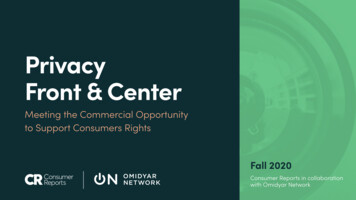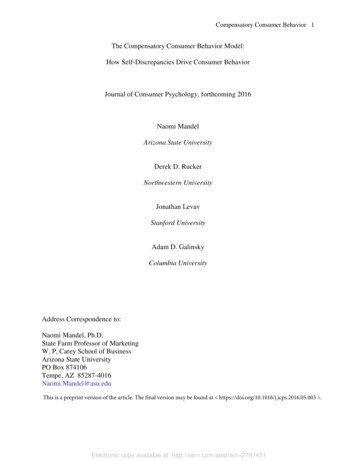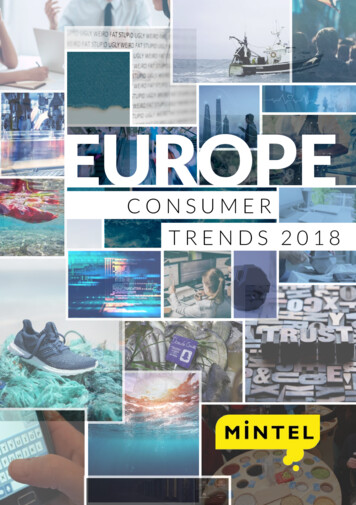
Transcription
EUROPECONSUMERTRENDS 2018
E D I T O R ’SN OT EHello and welcome to theconsumer trends that we believewill define the European region inthe coming year and beyond.Our trend predictionsare the product ofa methodology thatencompasses fourcomponents: we takeaccount of the pendingpolitical and legislativeevents and productlaunches due in 2018;the appetite amongstconsumers for theseevidenced by Mintelconsumer research;the momentum ininnovations we areseeing from our teamof global trend spotters;and the opinionsof Mintel’s expertindustry analysts.This year’s predictionsare in many waysreactions to theemerging challenges—environmental, political,technological andpsychological—we’reseeing across ourregion, but we areconfident that you canturn them to the goodof your business andto the benefit of yourfellow consumers.Best wishes forthe year ahead.Richard CopeSenior TrendsConsultantPAGE 5Sea ChangeOcean plasticfashion and recycledpackaging launches,ingredient bansand activism arefocusing consumerand governmentattention on maritimeconservation.PAGE 17ShareholdersHacks and data disclosurelegislation form a newbreed of consumerswho will hold on tight totheir data and demandsomething in returnbefore sharing it.PAGE 27TeenaidersCatherine CottneyManager of Trends,EMEATeens are increasinglydefined by anxietiesaround image, healthand work, and arelooking for brands toalleviate the pressureand help them buildboth their confidenceand prospects.PAGE 35AccountantsIn a world of post-truth politicsand unsubstantiated media,consumers are looking for brandsto court them with transparency,simplicity and evidence.
45SEA CHANGESEACHANGEOcean plasticfashion and recycledpackaging launches,ingredient bansand activism arefocusing consumerand governmentattention on maritimeconservation.
67SEA CHANGEWhat’s Happening In 2018?We expect that more andmore brands will offereducation and leadershipwith clean, safe andsustainable products thatdistinguish them from thecompetition as more foodand beauty brands seek tohighlight and safeguard thepurity and future supply oftheir ocean ingredients.Lobbying campaigns byGreenpeace will makeconsumers more awareof ocean plastic and itsimpact on wildlife andtheir own health. The UKgovernment’s ban on all‘rinse off’ personal careand cosmetic productscontaining microbeads, andScotland’s commitment toa deposit return schemeon plastic bottles, areinitiatives that manyEuropean countries wishto emulate, with Swedenset to do so for microbeadsby 2020. Politics will alsofocus European consumerattention on marineconservation, with Brexitnegotiations putting fishstocks on the agenda asthe UK withdraws fromthe London FisheriesConvention and CommonFisheries Policy in 2018.Government and lobbying campaignerswill make consumers more aware ofocean plastic and its impact on wildlifeand their own health.With Adidas making onemillion shoes from recycledocean plastic and Procter& Gamble committed tointroduce 25% recycledplastic across 500 millionbottles sold yearly on itshaircare brands, perceivedpolluters will be forcedto follow. Coca-Cola hasalready responded topressure by raising its 2020recycling target to 50%.More food andbeauty brands seekto highlight andsafeguard the purityand future supply oftheir ocean ingredients.
89SEA CHANGETrends in ActionProcter & Gambleplans to introduce 25%recycled plastic across500 million bottles soldyearly on its haircarebrands.Grandes OriginesSaumon Fumé d’Ecosse(Smoked Scottish Salmon)is marketed as beingselected from sitesknown for their qualityof water, heralding anew era of sourcing fromunpolluted areas.NegozioLeggero has 13stores stockingmore than1,500 packagefree productsacross Italy andSwitzerland.GanamosReciclando recyclingmachines rewardconsumers withpoints when theyrecycle materialslike paper or plasticbottles.In Spring 2017, Adidasdebuted their new editionsof its popular UltraBoostshoe, all made from plasticdebris found in the ocean.
10 11SEA CHANGEWhy ConsumersWill Buy Into ThisThe 267 species ofseabird and 61% ofturtles with plasticin their digestivetracts aren’t alone,with a third of thefish and shellfishhumans consumecontaining plastictoo, according toPlymouth University.The problem isescalating, with thevolume of oceanplastic predicted todouble in the nextdecade, accordingto the PlasticPollution Coalition.Lobbying isn’tabout to stop either,with Greenpeacehighlighting thatjust 14% of the600 billion bottlesproduced globallyin 2018 will berecycled. This isdespite the fact that,according to Mintel,66% of Polishconsumers preferto drink waterfrom a recyclablebottle. Meanwhile,two-fifths of Britsagree that pollutionlevels in the sourcearea of water area concern.Sustainability andthe environment arehigh on consumers’agenda, as Mintelresearch finds morethan half of UK fishconsumers would66% of Polish consumersprefer to drink water from arecyclable bottle.like suggestionsabout sustainablealternatives, whiletwo in five UKwomen aged 16-24would like to seemore eco-friendlyfabrics used inclothes. AcrossEurope, Mintel findsa quarter of Spanishand Germanconsumers agreethat being “betterfor the environment”is the number-onereason for buyingnatural and organicproducts; this isfollowed by arounda fifth of Italian andFrench consumers.
12 13SEA CHANGEBrands are responding tosustainability demands, asin Italy and Switzerland,Negozio Leggero has13 stores stocking morethan 1,500 package-freeproducts and, in France,Grandes Origines SaumonFumé d'Ecosse (SmokedScottish Salmon) ismarketed as being selectedfrom sites known for theirquality of water, heraldinga new era of sourcingUK consumer attitudes towards recycling products49% wouldbe interestedin buyingfashion itemsmade wholly/partiallyfromrecycledplastic72% would beinterested in buyingproducts withpackaging madewholly/partially fromrecycled plasticfrom unpolluted areas.While in Spain, GanamosReciclando combinesrecycling machines withincentives by rewardingconsumers with points whenthey recycle materials likepaper or plastic bottles. Themachine gives out moneyoff vouchers, discounts incertain stores and, in somecases, small amounts ofactual cash.79% believepeopleshould beincentivisedto recycleplastic73% would liketo see morefood/drink thatis guaranteed tobe sourced from(unpolluted)watersBase: 2,000 internet users aged 16 Source: Mintel Reports 2017
Where Next?Whilst plasticswon’t be whollydemonised (theyprolong shelf-lifeand prevent foodwaste) intensifiedeco-lobbyingwill producemore recyclableproducts. Expectto see incentivesand initiatives likesponsored ‘reverse’vending machines(such as thosewhich accept usedbeverage containersand return money tothe user) as well asmore governmentbacked variationson plastic-bagtaxes. We maywell see socialstigmatisationof plastic cupsand cling film,more pioneeringbrands innovatingwith soluble podpackaging, andmore retailersdispensing with itcompletely. In food,drink and beauty,we’ll see pure,unpolluted sourcingmainstream as aclaim and naturalexfoliators likesalt and sandchampionedalongside othersustainable marineingredients.Fashionable,premium oceanplastic products willpromote this trendin the coming year,but its consumeradoption will bedriven by healthand saving money,whilst for brands itwill become a normthat governmentsand lobbyistswill compel themto embrace.We may wellsee socialstigmatisationof plastic cupsand cling film,and morepioneeringbrandsinnovatingwith solublepod packaging.The world’sleading marketintelligence agencyWhat you need to knowabout consumers, markets andinnovation, now and in the future.How do we do it?Mintel’s global, specialist team of world-class analysts usethe most credible source of data, news and opinion. Theymine that data for innovation, trends and inspiration, so theycan give you a clear insight into what’s next.Credible DataInnovationTrendsLeading IndustryForecastingExpert Team50 years ofindustry experienceWhat’s next?ConsumersMarkets
16 17SHAREHOLDERSSHAREHOLDERSHacks and datadisclosure legislationform a new breed ofconsumers who will holdon tight to their data anddemand something inreturn before sharing it.
18 19SHAREHOLDERSWhat’sHappeningIn 2018?The data consumers aregenerating is escalating,but this data is creatingvulnerabilities, as highprofile hacks of Yahooaccounts and theWannaCry malware crisishave shown. In response,consumers will protectthemselves with softwareand behaviours learnedfrom the more streetwise,private approach ofyounger generations.At the same time,governments are providingprotection, with the UKseeking to emulate the EU’sGeneral Data ProtectionRegulation (GDPR)legislation, which fromMay 2018, will compelall businesses to seekconsumer consent, disclosetracking and offer the rightto be forgotten, when itcomes to data disclosure.This effectively reboots thedigital settings of the brandconsumer relationship andfrom now on brands willneed to proffer economicallyor personally compellingincentives for consumersto resume sharing theirinformation with them.Consumers will protectthemselves with softwareand behaviours learnedfrom the more streetwise,private approach ofyounger generations.
20 21SHAREHOLDERSWhy ConsumersWill Buy Into ThisMintel research revealsstrong consumer concernsaround both the tracking oftheir data and companies’ability to safeguard it.A meagre 8% of UKconsumers strongly agreethat banks can be trustedto keep personal data safefrom hackers/fraudsters.Meanwhile, two-thirdsof Brits worry abouthow brands track theironline activities.However, consumersare also open to dataexchanges in return forsavings, discounts andpersonalised offers. Forexample, over half of UKconsumers would be willingto share information from asmartwatch or fitness bandwith an insurance companyto help calculate the cost oftheir plan.UK willingness towardssharing financial data withdifferent providers75% Mymain bankBulgari has developedits own app to protectpersonal dataand passwords.41% Otherestablishedbankingprovider21% Otherbank that isrelatively newin the market28% Pricecomparisonwebsite17%Technologyfirms (egGoogle, Apple)Base: 2,000 internet users aged 16 Source: Current Accounts, UK 2017
22 23SHAREHOLDERSWearable devices andsmart TVs present majoropportunities here, butcompanies will need toincentivise consumersto raise their ownershiplevels as according toMintel, less than one in 10French, German, Italian andSpanish consumers own asmartwatch. Streaming TVdevice ownership remainslow too, with ownershippeaking at 13% in Italy andGermany (respectively),followed by 11% in Franceand 9% in Spain.Bud, a technology platformbased in the UK, links users’financial services togetherin a single interface. BulgariTHERO is a3D-printed desktopdevice that allowsusers to switchbetween encryptedcommunicationmethods simply byturning a dial.has developed its ownapp to protect personaldata and passwords—acustomised version ofWISeID from SwisseSecurity firm WISeKey.Meanwhile, THERO is aphysical desktop device outof Spain that gives onlineprivacy and protection atangible form.Bud enables users to view and interact withall their finances in one placeConsumersare open todata exchangesin returnfor savings,discounts andpersonalisedoffers.
WhereNext?As data creation grows innew forms—whether it isbiometrics, geolocationapps or the Internet ofThings (IoT)—more trustedoutsider brands will enterthe protection market. Butwe’ll also see children andteens lead an educationdrive amongst parents inregards to data privacy.Families will also be afocus for the increasinglyon-trend desire for moreprivate leisure capsules ofdigital downtime by way ofvisceral, sensory or slower,more mindful, analogueexperiences. The key issuehere is that brands aresuddenly confronted withlegislation that makes thefuture of online advertisingabout an unknowable user.Looking ahead, newlyempowered consumerswill benefit as brandssolicit them. Whilstdiscounting for dataschemes will mainstream,we’ll also see morecreative data-sharinginitiatives that helpconsumers to save time andbetter monitor their healthor their utilities spending.MINTELBIG CONVERSATIONSGet insight and inspiration, engage inmeaningful conversations and explorethe potential for your business to grow.To find out more information onany Big Conversation event email:bigconversations@mintel.com
26 27TEENAIDERSTEENAIDERSTeens are increasinglydefined by anxietiesaround image, healthand work, and arelooking for brands toalleviate the pressureand help them buildboth their confidenceand prospects.
28 29TEENAIDERSAccording to Samsung,“Selfie Mode gives you thetools to take your selfies toanother level creatively”.There is agrowingunderstandingof the digitalpressuresfacing youngpeople and howparents areadding to theseproblems.What’s Happening In 2018?Pan-Europeanstudies reveal theeconomic, digitaland emotionalpressures facingtoday’s youth,demanding aresponse fromconsumer-facingbrands. Whilstaccording toEurostat, youthunemploymentacross the EU-28has fallen from23.9% in March2013 to 16.9% inJuly 2017, theserates remain doublethe rates for thegeneral populationand we’re startingto see automationencroach onyouth employmentprospects. Manyjob categories areunder threat, withyouth-focusedroles, telemarketingand cashier rolesproving the mostvulnerable.There is a growingunderstanding ofthe digital pressuresfacing youngpeople and howparents are addingto these problems.In the UK, studiesby Ofcom andthe University ofSheffield haveshown that the timespent online bythose aged 8-15has doubled in thepast decade andthat spending justone hour each dayon social mediareduces happinessindexes by 14%.These emergingpressures aroundonline bullying,body image (filtersand functions likeSamsung’s SelfieMode have becomethe norm) andacademic stressare contributinggreatly to an 18%global growth indepression overthe past decade,according to theWorld HealthOrganization(WHO). By way ofresponse, we’reseeing moremental healthand well-beingcharities—like theUK’s YoungMinds—focused on theneeds of today’syouth.
30 31TEENAIDERSWhy ConsumersWill Buy Into ThisMental health issues arebecoming more prevalentamongst teens. Mintelresearch finds a quarterof 7-15 year olds areconcerned about their futureafter school, with the samenumber concerned abouttheir appearance. Andsocial media usage is beingheld as a main contributor.In the UK, the Royal Societyfor Public Health hasrevealed that four of thefive most popular forms ofsocial media have beenfound to harm youngpeople’s mental health, withInstagram highlighted asthe most damaging. Whilein Ireland, 72% of Irish 1319 year olds say that bodyimage has caused themstress or difficulty, with 43%saying social media hasdone the same.The ASOS 2017campaign left itsmodels unairbrushed,with stretch marks,cellulite and all theother skin ‘perfections’.Sources of anxiety for UK children and teens44% SchoolworkBOYS10%16%28%AGE 7-9AGE 10-12AGE 13-1539% Relationship with your friends25% Family having enough money25% Future after school24% Appearance12% Social media11% Relationship with your parents7% Politics in UKGIRLS12%28%52%Base: 1,500 internetusers aged 7-15Source: Lifestylesof Children andTeens UK 2017
32 33TEENAIDERSThe emergingissue is that evenbefore the youngergeneration wasable to walk ortalk, their everymove was beingdocumented onlineby their parents andfamily members.Indeed, accordingto Ofcom, four in 10UK parents sharephotos of theirchildren on socialmedia, with halfof these parentsposting photos atleast once amonth. However,switching offcompletely fromdigital platformsis not the answeras these channelscan be utilisedto raise awarenessand quickly connectyoung consumerswith the helpthey need.Brands arerecognising therole they canhave in improvingmental health byhighlighting greaterdiversity in terms ofthe models they useand the depictionsthey portray. Britishonline fashion andbeauty store ASOSis being praisedon social media forfeaturing modelswith stretch marks;meanwhile, IRIS ONis a Dutch schemethat offers childrena chance to fightbullying throughWhatsApp.Where Next?Young people willexpect brands tooffer support whenit comes to theirhealth and wellbeing, as well asget more involvedin their educationand development.With a growing levelof attention aroundthe negative impactof social media,this generation willseek to take backgreater controlby being moremindful of theirusage. They willbe quick to call outbrands promotingunrealistic beautyideals and quickto support thoseembracing diversity.Today’s youth arefacing an uncertainfuture and theimpact of dealingwith this has thepotential to followthem for the rest oftheir lives if nothingis done now. In2018 and beyond,brands have anopportunity tostep in and providesolutions tohelp empowerthis cohort.With a growing level of attentionaround the negative impact of socialmedia, this generation will seek totake back greater control by beingmore mindful of their usage.IRIS ON allows youngconsumers to talk toa chatbot called Iris,offering children a chanceto fight bullying.
34 35ACCOUNTANTSACCOUNTANTSIn a world of posttruth politics andunsubstantiatedmedia, consumersare looking for brandsto court them withtransparency, simplicityand evidence.
36 37ACCOUNTANTSWhat’sHappeningIn 2018?Consumer distrust ingovernments and media isspreading to companies,and so is the clamour fortruth and transparency iningredients and behind-thescenes processes. We’llsee greater accountabilityin politics, media andemployment in the formof Claimbuster’sAI-backed fact-checkingservices, Germany’sNetwork EnforcementAct against fake newsand hate speech, and theUK government compellingcompanies with more than250 employees to publishtheir gender pay gap data;and this will extend to theconsumer realm. Moreand more companies willtake an ‘open kitchen’approach and use theirpackaging, portals andpremises to practise truthand transparency. Expectmore brands to follow thepioneering approachesof fast-moving consumergoods (FMCG) companieslike SC Johnson, Lush andMethod when it comes toexplaining ingredientsand sourcing. Other brandsto follow include fashionretailers like Everlane andReformation who provideprice breakdowns andenvironmental scores,and online retailbehemoth Amazonoffering the ultimate inopenness: warehousetours for customers.More and morecompanieswill take an‘open kitchen’approachand use theirpackaging,portals andpremisesto practisetruth andtransparency.
38 39Trends in ActionLush Ltd.promotes anethical buyingpolicy.French supermarketchain U took advantageof Snapchat Stories (andthe fact they disappearafter 24 hours) todemonstrate that its fishis freshly caught.Everlane reveals thetrue costs behind allof its products, frommaterials to labourto transportation.Products are thenoffered, minusthe traditionalretail markup.ACCOUNTANTSMethod disclosesthe ingredients inall products andthe processes theyuse to make them.Renault offered a candid view ofhow its Scénic model is equippedto handle the trials of familylife in ‘Behind Car Doors’, acampaign fronted by two leadingInstagram parents.
Why ConsumersWill Buy Into ThisBlind trust in companiesor institutions is a thingof the past. According toMintel research, just 25%of those who have used adevice to access nationalnewspapers online saythat the content on thesewebsites is trustworthy.Social media has enabledempowered consumersto instantly question andtake brands to task whentheir actions cause concernor confusion. Consumersare utilising the tools attheir disposal to keep aneye on what companiesare doing, with Mintelresearch showing that atleast half of Europeansagree the increasedEuropean agreement thatsocial media is forcing foodand drink companies to bemore transparent*65% Italianability of consumers tocommunicate and findinformation via social mediaand the internet is forcingcompanies to be moretransparent. However, manyconsumers—especiallyat the younger end ofthe spectrum—expectcompanies to take amore proactive, high-techapproach when it comesto increasing transparency.One in five 20-24-yearold Brits would like onlineretailers to have videosshowing how clothes andshoes are made.63% Spanish60% Polish54% German50% French*Consumers were asked if they agreed that theability to communicate and find information viasocial media/the internet is forcing food anddrink companies to be more transparent.Base: 2,000 adults aged 16 Source: Mintel Reports 2017
Where Next?Social media has enabledempowered consumersto instantly questionand take brands to taskwhen their actions causeconcern or confusion.Brands are respondingto this demand fortransparency, as in theautomobile sector, Renaulthas hired two popularInstagrammers for a yearlong campaign to show howits latest Scénic vehiclecan handle the rigours offamily. Meanwhile, Frenchsupermarket chain U’s 2017campaign uses SnapchatStories to demonstrate justhow fresh its fish are. AndVodafone has unveiledplans to block its advertisingfrom appearing on fakenews websites or those thatcontain hate speech.Quantified and qualifiedfacts will be in high demandand consumers will expectgreater transparency asstandard, whether this isrelated to manufacturingprocesses or how efficaciousa product is. In terms ofmarketing, there will be apush for greater authenticity;consumers are set to seebehind-the-scenes revealedthrough creative campaignsthat put employees to thefore and capitalise on theiryears of expertise.With consumers more ableto question and query theactions of brands, radicaltransparency will be thewatchword for 2018 as theytry and show they can berelied upon as trustworthy.Radicaltransparencywill be thewatchword for2018 as brandstry and showthey can berelied upon astrustworthy.
mintel.com 2017 Mintel Ltd. All rights reserved.
UK consumer attitudes towards recycling products Base: 2,000 internet users aged 16 Source: Mintel Reports 2017 79% believe people should be incentivised to recycle plastic 73% would like to see more food/drink that is guaranteed to be sourced from (unpolluted) waters 72% w
